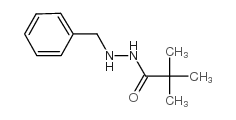306-19-4
| Name | N'-benzyl-2,2-dimethylpropanehydrazide |
|---|---|
| Synonyms |
Tersavide
Pivazid N'-benzyl-2,2-dimethyl-propanehydrazide N'-benzylpivalohydrazide Betamezide N-Benzyl pivalhydrazide Pivalylbenzhydrazine 1-Trimethylacetyl-2-benzyl-hydrazin Tersavid PIVHYDRAZINE Pivalyl benzylhydrazine Pivaloylbenzylhydrazine Betamezid |
| Description | Pivalylbenzhydrazine (Pivhydrazine) is a potent monoamine oxidase (MAO) inhibitor. Pivalylbenzhydrazine decreases cartilage growth in normal rats. Pivalylbenzhydrazine can be used in research of depression[1]. |
|---|---|
| Related Catalog | |
| In Vivo | Pivalylbenzhydrazine (Pivhydrazine; 5 mg/kg; i.p.; daily, for 5 d; immature female rats) inhibits the growth of the epiphysial cartilage[1]. Animal Model: Immature female rats (40 g, 3-4 weeks age)[1] Dosage: 5 mg/kg Administration: Intraperitoneal injection; daily, for 5 days Result: Inhibited the growth of the epiphysial cartilage |
| Density | 1.015g/cm3 |
|---|---|
| Boiling Point | 296.1ºC at 760mmHg |
| Molecular Formula | C12H18N2O |
| Molecular Weight | 206.28400 |
| Flash Point | 105.6ºC |
| Exact Mass | 206.14200 |
| PSA | 41.13000 |
| LogP | 2.63530 |
| Index of Refraction | 1.517 |
CHEMICAL IDENTIFICATION
HEALTH HAZARD DATAACUTE TOXICITY DATA
MUTATION DATA
|
| RIDADR | UN 3249 |
|---|---|
| Packaging Group | III |
| Hazard Class | 6.1(b) |
| HS Code | 2928000090 |
| HS Code | 2928000090 |
|---|---|
| Summary | 2928000090 other organic derivatives of hydrazine or of hydroxylamine VAT:17.0% Tax rebate rate:9.0% Supervision conditions:none MFN tariff:6.5% General tariff:20.0% |
